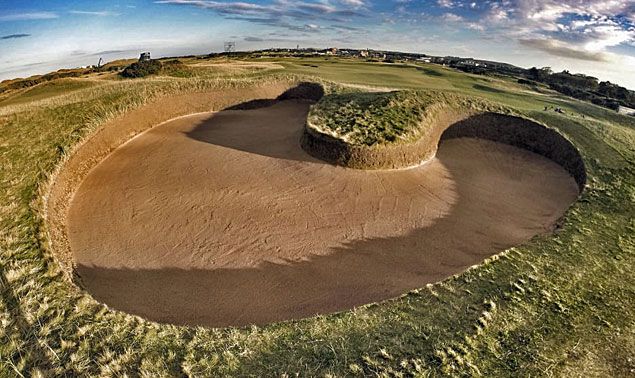L is for LONG
THE ORIGINAL
“Long,” No. 14 at St. Andrews Old Course is the longest hole on the card. This and some other details from the Scottish icon have come to solidify our understanding of the term “Long”.
Most templates put emphasis on approach shots—whether that’s an iron to a Par 3, or the careful measure of distance when crossing an “Alps.” Two good shots are required to reach any solid template Par 4, of course, but George Bahto justifies the importance of the tee on “Long” as a three-shot template: “The hole requires a long, deadly accurate tee shot between out-of-bounds and a hazard. An errant first stroke will leave the golfer with a continuing problem all the way to the green.”
The “deadly accuracy” should be aimed at the “Elysian Fields,” a rare flat area on the course, which sits at the right-centre of the fairway. This involves the diagonal carry of the aforementioned hazard, without flying the wall that marks “out-of-bounds.” Having safely arrived at Elysian, the player has a better chance at carrying the Hell Bunker, a six foot-deep pit more than 75 yards long and covering more than 300 square yards. Those with weak tee shots should be wary of tempting fate, and are encouraged to use the No. 5 fairway as a detour to the green (which does not necessarily guarantee safe passage of Hell). Even avoiding Hell, the player must deal with devilish mounding on their approach from this position, deflecting balls away during the prescribed ground approach (having carried Hell, the player has a shorter, more head-on approach).

Hell Bunker St Andrews Old course 14th hole - image courtesy of the European Tour
The giant bunker obviously holds significant sway in this Par 5 template. Sound familiar? We’re getting there...
The Long is a less popular template largely because the Knights Template—C.B. Macdonald, Seth Rayor and Charles Banks—did not use it definitively. Only two examples of defined “Longs” existed in the United States. One was at Macdonald and Raynor’s legendary Lido Golf Club, a spot-on recreation of the St. Andrews model. The other, still existing, sits among Macdonald’s other templates at the National Golf Links of America. Although not a clone, No. 9 shares several elements with “Long,” including its name. The tee shot crosses a pond and a set of bunkers diagonally; the more daring first shot means a less stressful second. The safer line from the tee means reckoning with a smorgasbord of sand concepts. NGLA’s “Hell” isn’t one bunker, but a string of hazards that includes one large “regular” sand pit, an Oakmont-style set of church pews, and a series of smaller bunkers stitched together with scrub grass. For its lack of St. Andrews mounding, Macdonald included several bunkers bordering the green. Although it is no longer the epic closer at NGLA since the clubhouse moved, “Long” is still the lengthiest hole at the course.

NGLA 9th hole - image courtesy of Jon Cavalier @LinksGems
Bahto suggests that Macdonald and his acolytes avoided “Hell” bunkering at future three-shot holes out of fear that it required skills unreasonable for the standard player of the era. At least one other Golden Age architect was happy to step in on behalf of “Hell”.
A.W. Tillinghast, unlike Raynor and Banks, did visit St. Andrews during his lifetime, and it’s reasonable to assume Hell had an impact on the young golfer. He found an ally in hotelier George Crump. “The three-shot hole must be beyond the range of any player who misses either his drive or second stroke,” Tillie wrote. “The most effectual method, and I believe the only satisfactory one, is the location of a truly formidable hazard across the fairway... Obviously this break in the fairway must be great, let us say 100 yards.”

Pine Valley 7th hole - Hell's Half Acre
And so “Hell’s Half Acre” was born, the No. 7 hole at Pine Valley. The formula for this example of what is now known as “Tillinghast’s Great Hazard” is simple: A strong tee shot will set the player up with the opportunity to clear the title “half-acre” (at one time the hazard occupied more than an acre) and be rewarded with an easier approach. A tee shot to the rough inevitably means laying up, and then playing the third shot over the hazard (with no real chance of reaching in regulation). The most devilish scenario, however, is a weaker tee shot to the fairway, where the player must debate laying up or challenging the beast. The length of this forced carry—more than 150 yards—is enough to rattle many.
Pine Valley’s “Long” is based almost purely on the talent and confidence of the player, with little room for strategic manoeuvring (even the green, upon approach, sits as an island in its own large bunker). Tillinghast adapted his concept to improve the hole’s strategy, even if that Par 5 is far from the longest on the course. A classic example is No. 4 at Bethpage Black. The Great Hazard here cuts from long-and-right down to near-and-left—decreasing in altitude as it comes forward, offering several routes for players. Those daring enough to go for two must carry another large bunker from the tee and stop short of the Great Hazard for the shortest line to the green. More conservative players can avoid the initial bunker by playing right, but they’ll face the longest, tallest carry of the Great Hazard in order to reach the next fairway. If the player who was more aggressive has second thoughts and opts to aim for the second fairway, their carry will be shorter, in both length and height.

Bethpage Black course 4th hole - image courtesy of John Sabino
Traditionally, the “Great Hazard” has, of course, been sand. Both Tillinghast and others have worked sans sand, however. A.W.’s work at Ridgewood Country Club in New Jersey includes two Par 5s that consist of deep rough, presumably more affordable than sediment. Perhaps the most famous version, however, comes at Hirono, the greatest of C.H. Alison’s many great Japanese courses. No. 15 uses the property’s prominent trench as a daunting deterrent. Interestingly, it’s not even the most popular hazard on the hole; the pine tree in the first fairway is iconic. You’ll be less keen, of course, if you land too far to the left, and it forces you to take an extra shot before crossing the hazard.

Pinehurst No.4 course 9th hole - image courtesy of the Pinehurst Resort
Although Par 5s continue to get longer, there’s less interest in maintaining (or paying to maintain) epic hazards such as “Hell” or “Hell’s Half Acre.” Still, naturally sandy terrain offers some opportunity for new levels of “Hell.” One example is No. 9 at Gil Hanse’s redesign of Pinehurst No. 4. Again, it is certainly not the longest Par 5 on the route, but it does require strategic interaction with the large hazard to determine the final score. The shortest carry is to the far left, but this will leave the trickiest approach into a right-to-left green, fronted by a bunker at its left foot. The longest carry, well over 100 yards, will leave the optimal approach angle from the right.
MAYBE...MAYBE NOT
First, let us cull a whole range of would-be “Great Hazards”: A Par 4 simply does not apply, no matter how much sand must be carried. Tillinghast defined his “Great Hazard” as a “three-shot-hole,” and no Par 4 is long enough to justify the term “Long.”
There are many Par 5s that could claim a “great hazard” among their ranks but do not necessarily qualify as a “Long,” or even a “Tillinghast’s Great Hazard.” We’ll head back to Bethpage Black for another example. No. 7 features a trap that is almost three times larger than No. 4’s hazard, and the hole is longer as well. The difference with this hazard, however, is that the player must carry it from the tee; they have no safe alternative. On a true “Great Hazard,” players get the option to put themselves in a better position before challenging the carry. This is strictly a do-or-die scenario. Granted, the diagonal tee shot allows players to choose how much sand they want to bite off, but this makes it more of a Cape than a “Long.”

Tobacco Road 11th hole - image courtesy of David Davis
Tobacco Road’s No. 11 is a Par 5 that offers a 150-yard crossing of a massive sand hazard. This route is forced upon only those aiming for eagle, however. Those who can’t land their second softly on a 10-yard wide target after the lengthy carry will roll into yet another sandpit. The rest of us don’t necessarily need to carry the sand at all... we can take a safer, three-shot route across 511 yards of uninterrupted fairway around the hazard. The green, surrounded on three sides by sand, is realistically more of a Cape than a “Long.” We apologize for not mentioning it several posts ago.
